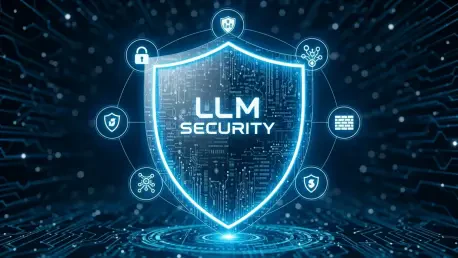Introduction to LLM Security Challenges
In an era where enterprise innovation hinges on the power of artificial intelligence, Large Language Models (LLMs) have become indispensable tools for driving efficiency and unlocking new capabilities across various industries. Yet, with their widespread adoption, a staggering statistic emerges: over 60% of organizations deploying AI packages have at least one known vulnerability, according to recent industry findings. This alarming reality underscores a critical challenge for Chief Technology Officers (CTOs) tasked with harnessing LLM potential while safeguarding their systems against an ever-evolving array of cyber threats. As these models integrate into core business processes, the attack surfaces they introduce demand urgent attention and strategic action.
The reliance on LLMs spans startups, scale-ups, and established enterprises, transforming operations with unprecedented speed and innovation. However, this transformation comes at a cost, as each deployment widens the potential for data breaches, system manipulation, and regulatory non-compliance. Key industry players, such as providers of advanced models like GPT, Perplexity, and Gemini, share responsibility with organizations to secure these technologies, but the onus often falls on CTOs to bridge the gap between vendor assurances and real-world risks. Amid rising cyber threats and increasing regulatory scrutiny, securing LLMs is not just a technical necessity but a business imperative.
The Rising Significance of LLM Security
The growing dependence on LLMs in enterprise environments reflects their ability to streamline workflows, enhance decision-making, and foster creativity. From automating customer interactions to generating complex analytical insights, these models are redefining operational paradigms. However, their integration into sensitive systems amplifies vulnerabilities, creating new entry points for adversaries seeking to exploit data or disrupt services. This dual nature of opportunity and risk places LLM security at the forefront of strategic planning for technology leaders.
Beyond the immediate benefits, the broader implications of LLM adoption reveal a landscape fraught with challenges. As these models process vast amounts of sensitive information, the potential for data leakage or misuse escalates, especially when inputs and outputs are not adequately protected. The shared responsibility model between vendors and organizations further complicates the scenario, requiring CTOs to implement robust safeguards that complement vendor-provided security measures. In an environment where cyber threats are becoming more sophisticated, proactive defense is essential to maintaining trust and operational integrity.
Regulatory pressures add another layer of complexity to this dynamic. With stricter data protection laws and heightened expectations for compliance, organizations must navigate a maze of legal obligations while deploying LLMs. The intersection of technological innovation and regulatory demands creates a pressing need for security frameworks that not only mitigate risks but also ensure adherence to global standards. For CTOs, addressing these multifaceted challenges is critical to sustaining competitive advantage and protecting stakeholder interests.
Delving into the Threat Landscape for LLMs
Primary Security Risks Facing LLMs
LLMs face a spectrum of security risks that can compromise their integrity and the systems they support. Inference attacks, where adversaries extract sensitive training data through subtle probing, pose a significant threat, often revealing personal or proprietary information. Prompt injection, another critical risk, allows malicious inputs to bypass safeguards, potentially exposing system instructions or triggering unauthorized actions. Data poisoning, meanwhile, introduces corrupted data during training or fine-tuning, embedding hidden backdoors that can be exploited later.
Additionally, overdependence on LLM outputs without proper validation can lead to operational errors or cyber-physical risks, especially when automated actions are based on flawed predictions. Regulatory violations further compound the issue, as mishandling data during inference can breach laws like GDPR or HIPAA, resulting in severe penalties. These threats manifest in real-world scenarios through data leaks, system manipulation, or compliance failures, often with cascading effects on business operations.
Emerging attack vectors, such as zero-day exploits targeting model-specific weaknesses and adversarial inputs designed to confuse safety mechanisms, are becoming more prevalent. These sophisticated methods exploit gaps in traditional defenses, highlighting the need for specialized security approaches. As attackers refine their techniques, understanding and anticipating these risks becomes a cornerstone of effective LLM protection strategies for technology leaders.
Assessing the Impact and Prioritization of Threats
Recent data from industry reports, such as Orca Security’s findings, reveal that over half of organizations adopting AI for custom applications do so with insecure defaults, amplifying exposure to threats. This statistic illustrates the pervasive nature of vulnerabilities in LLM ecosystems, where unpatched dependencies and configuration drift are common. The financial impact of a successful attack can be staggering, with costs stemming from ransom demands, incident response, and regulatory fines often exceeding initial budgets for model deployment.
Reputational damage represents another critical consequence, as breaches involving customer data or internal communications erode trust and attract negative public scrutiny. Operationally, organizations may face disruptions, including the need to disable features or roll back deployments, which delays innovation and consumes valuable resources. These combined effects underscore the urgency of prioritizing security measures that address high-risk areas like inference attacks and prompt manipulation over less immediate concerns.
Looking ahead, the threat landscape is expected to evolve with increasing sophistication, driven by advancements in adversarial tactics and the integration of agentic tools with LLMs. Proactive mitigation, supported by continuous evaluation and threat intelligence, is vital to staying ahead of these developments. For CTOs, aligning security efforts with business impacts ensures that resources are allocated effectively to safeguard critical assets against both current and emerging dangers.
Addressing Challenges in Securing LLMs
The technical hurdles in securing LLMs are formidable, with issues like model drift—where performance or security degrades over time due to data or parameter changes—posing ongoing risks. Supply-chain vulnerabilities in open-source components, often integral to LLM stacks, create additional weak points, as unpatched flaws in libraries or frameworks can be exploited. Over-reliance on vendor guarantees further complicates the situation, as these assurances may not cover adversarial behaviors unique to generative systems.
Operational challenges also loom large, with complacency in non-production environments leading to overlooked vulnerabilities in development or staging setups. Misconfigured APIs, even those marketed as secure by default, can inadvertently expose sensitive data through excessive logging or broad permissions. These pitfalls highlight the necessity for rigorous internal controls that go beyond vendor promises and address the specific nuances of LLM deployments.
To counter these obstacles, solutions such as continuous monitoring for anomalous behaviors and adversarial testing to uncover weaknesses before exploitation are proving effective. Implementing robust access controls, including least-privilege roles and ephemeral credentials, minimizes the blast radius of potential breaches. By embedding security into every phase of the LLM lifecycle, organizations can build resilience against both technical and operational risks, ensuring sustainable and secure adoption.
Navigating Regulatory and Compliance Demands for LLMs
Data protection regulations like GDPR, HIPAA, and CCPA impose stringent requirements on LLM deployments, treating inference as data processing with associated obligations. These laws demand careful handling of prompts, contexts, and outputs, especially when sensitive information crosses jurisdictional boundaries. Non-compliance can result in significant fines and legal repercussions, making regulatory alignment a top priority for organizations leveraging these models.
Compliance challenges extend to practical issues, such as auditability gaps with black-box APIs that obscure data lineage and processing details. Cross-border data transfers often violate sovereignty rules if endpoints are non-compliant, while data retention policies must be enforced with precision to meet legal timelines. These complexities require a structured approach to ensure that LLM systems adhere to both local and international standards without compromising functionality.
Adopting privacy-by-design principles offers a path forward, integrating consent enforcement and detailed processing records into system architecture. By embedding mechanisms for data erasure and purpose limitation directly into workflows, organizations can demonstrate accountability during audits. Prioritizing these measures not only mitigates regulatory risks but also builds customer confidence in the ethical use of advanced AI technologies.
Looking Ahead: Future Directions in LLM Security
Emerging technologies are shaping the next frontier of LLM security, with differential privacy providing a means to protect training data while maintaining model utility. Advanced red-teaming exercises, simulating real-world attacks, help uncover vulnerabilities before they are exploited, while automated anomaly detection systems identify unusual patterns indicative of threats. These innovations promise to enhance defenses without sacrificing the performance gains that LLMs deliver.
Potential disruptors, including rapidly evolving cyber threats and shifting regulatory landscapes, will continue to challenge existing security paradigms. The integration of agentic tools with LLMs introduces new risks, as increased autonomy heightens the potential for unintended actions if not tightly controlled. Balancing these factors with the need for operational efficiency requires a forward-thinking approach that anticipates change rather than merely reacting to it.
Global economic and geopolitical dynamics also play a role in shaping LLM adoption and security strategies. As nations prioritize data sovereignty and impose stricter controls, organizations must adapt to fragmented compliance requirements. Innovation in this space will be key, ensuring that security measures evolve in tandem with technological advancements and external pressures, ultimately fostering a resilient ecosystem for LLM deployment.
Key Takeaways and Recommendations for CTOs
Securing LLMs demands a defense-in-depth approach that integrates people, processes, and technology to address the multifaceted nature of cyber threats. This strategy emphasizes layered protections, from data sanitization to runtime monitoring, ensuring no single point of failure can compromise the entire system. For CTOs, this holistic perspective is essential to mitigating risks while maximizing the value of AI investments.
Actionable steps include embedding security into the development lifecycle through automated checks and adversarial testing, as well as prioritizing data hygiene to prevent leakage or poisoning. Fostering a culture of continuous hardening, where teams routinely update defenses based on threat intelligence, further strengthens resilience. Regular audits and policy reviews should be standard practice to maintain alignment with evolving regulatory expectations.
Looking toward the future, building robust LLM programs requires adaptability to withstand both current and emerging challenges. CTOs should focus on creating scalable frameworks that integrate seamlessly with business objectives, ensuring security enhances rather than hinders innovation. By committing to these principles, organizations can navigate the complex landscape of cyber threats and regulatory demands with confidence and foresight.
Reflecting on Insights and Future Actions
The exploration of LLM security underscores the intricate balance between leveraging cutting-edge technology and safeguarding against sophisticated cyber risks. Discussions with industry leaders revealed a consensus on the urgency of addressing vulnerabilities like prompt injection and data poisoning through proactive measures. The analysis of regulatory landscapes highlighted the growing importance of compliance as a competitive differentiator in a global market.
Moving forward, CTOs are encouraged to invest in emerging solutions such as automated anomaly detection and privacy-preserving techniques to stay ahead of adversaries. Collaboration across sectors emerged as a vital next step, with shared threat intelligence offering a pathway to collective defense. By focusing on these actionable strategies, technology leaders can position themselves to transform challenges into opportunities for sustained growth and trust.









